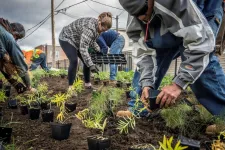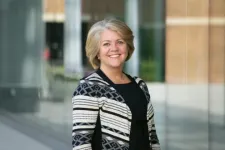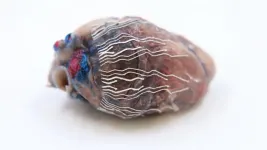(Press-News.org) As pandemic restrictions begin to loosen around the country and summer temperatures rise, more people will be moving about on public rideshare electric scooters. With that comes this warning: Ride with safety.
A Henry Ford Health System study published in The Laryngoscope, shows that head and neck injuries caused by use of e-scooters have been on the rise since rideshare systems were introduced to the public in late 2017.
Kathleen Yaremchuk, M.D., Chair of the Department of Otolaryngology - Head and Neck Surgery and the study's senior author, said that a review of emergency visits in the last three years showed e-scooter injuries have increased significantly with many related to head and neck injuries. "Since e-scooters became a popular form of transportation in major cities, the number of injuries jumped significantly because they've become more available to more people," said Dr. Yaremchuk.
Henry Ford researchers looked at available data from the U.S. Consumer Product Safety Commission and found that between January 2009 and December 2019 there were more than 100,000 e-scooter related injuries reported. The study found that head and neck injuries made up nearly 28% of the total e-scooter related injuries reported.
Dr. Yaremchuk hopes that local and national regulations can be developed to increase ride safety.
Researchers found that since the introduction of rideshare e-scooters, motorized vehicles that can reach speeds of up to 35 miles per hour, injuries have increased as more people gravitate to the inexpensive and convenient form of transportation used mostly in crowded urban centers and on college campuses.
"We hope our findings will help educate users of rideshare e-scooters about the potential for serious head and neck injuries and the safety precautions they should take," said Dr. Yaremchuk.
E-scooters are part of the Micromobility revolution that has been called the future of urban transportation. Serious injuries, though, are mounting among riders who find themselves unguarded against cars and bicycles and fixed street ornaments like light poles and signs.
The study found common types of e-scooter related head and neck injuries included:
Internal organs, including brain injuries, 32.5%
Lacerations, 24.9%
Contusions and abrasions, 15.6%
Concussions, 11.1%
Fractures, 7.8%
"As a physician, I would recommend that people who use this mode of transportation wear a helmet and apply the same approach as when driving a car," said Samantha Tam, M.D., a Henry Ford otolaryngologist and study co-author.
If you plan to ride an electric scooter, here are a few safety tips to reduce your risk for injury:
Wear a helmet, knee and elbow pads
Wear appropriate clothing that won't constrict your body while riding
Understand the specifications, features and capabilities of the specific e-scooter you are riding
Observe traffic laws, focus on the path ahead and watch for pedestrians, cars and other obstacles
Safety research has shown that e-scooter accidents involved cars and ground obstacles such as curbs, poles and even manhole covers. Other factors that led to accidents include mechanical problems such as failing brakes and wheels, and distracted riders.
INFORMATION:
NEWS MEDIA CONTACT: Sal Giacona / sgiacon1@hfhs.org / 313-421-9108
About Henry Ford Health System
Founded in 1915 by Henry Ford himself, Henry Ford Health System is a non-profit, integrated health system committed to improving people's lives through excellence in the science and art of healthcare and healing. Henry Ford Health System includes Henry Ford Medical Group, with more than 1,900 physicians and researchers practicing in more than 50 specialties at locations throughout Southeast and Central Michigan. Acute care hospitals include Henry Ford Hospital in Detroit, MI and Henry Ford Allegiance Health in Jackson, MI - both Magnet® hospitals; Henry Ford Macomb Hospital; Henry Ford West Bloomfield Hospital; and Henry Ford Wyandotte Hospital.
The largest of these is Henry Ford Hospital in Detroit, a quaternary care research and teaching hospital and Level 1 Trauma Center recognized for clinical excellence in cardiology, cardiovascular surgery, neurology, neurosurgery, and multi-organ transplants. The health system also provides comprehensive, best-in-class care for cancer at the Brigitte Harris Cancer Pavilion, and orthopedics and sports medicine at the William Clay Ford Center for Athletic Medicine - both in Detroit.
As one of the nation's leading academic medical centers, Henry Ford Health System annually trains more than 3,000 medical students, residents, and fellows in more than 50 accredited programs, and has trained nearly 40% of the state's physicians. Our dedication to education and research is supported by nearly $100 million in annual grants from the National Institutes of Health and other public and private foundations.
Henry Ford's not-for-profit health plan, Health Alliance Plan (HAP), provides health coverage for more than 540,000 people.
Henry Ford Health System employs more than 33,000 people, including more than 1,600 physicians, more than 6,600 nurses and 5,000 allied health professionals.
In the Name of Racial Justice: Why Bioethics Should Care about Environmental Toxins
Keisha Ray
Facilities that emit hazardous toxins, such as toxic landfills, oil refineries, and chemical plants, are disproportionately located in predominantly Black, Latinx, and Indigenous neighborhoods. Environmental injustices like these threaten just distribution of health itself. Facilities that emit environmental toxins wrongly make people's race, ethnicity, income, and neighborhood essential to who is allowed to breathe clean air and drink clean water, and thus, who is allowed to be healthy. This ...
A large, retrospective, multicenter study involving Washington University School of Medicine in St. Louis indicates that convalescent plasma from recovered COVID-19 patients can dramatically improve likelihood of survival among blood cancer patients hospitalized with the virus.
The therapy involves transfusing plasma -- the pale yellow liquid in blood that is rich in antibodies -- from people who have recovered from COVID-19 into patients who have leukemia, lymphoma or other blood cancers and are hospitalized with the viral infection. The goal is to accelerate their disease-fighting response. Cancer patients may be at a higher risk of death related to COVID-19 because of their weakened immune systems.
The data, collected as part ...
A new article, published as a Perspective in the journal Conservation Science and Practice, introduces a rapid assessment framework that can be used as a guide to make conservation and nature-based solutions more robust to future climate.
Climate change poses risks to conservation efforts, if practitioners assume a future climate similar to the past or present. For example, more frequent and intense disturbances, such as wildfire or drought-induced tree mortality, can threaten projects that are designed to enhance habitat for forest-dependent species and sequester carbon. Overlooking such climate-related risks can result in failed conservation investments and negative outcomes for people, biodiversity, and ecosystem integrity as well as lead to carbon-sink reversal. Drawing ...
The Black Sea is an unusual body of water: below a depth of 150 metres the dissolved oxygen concentration sinks to around zero, meaning that higher life forms such as plants and animals cannot exist in these areas. At the same time, this semi-enclosed sea stores comparatively large amounts of organic carbon. A team of researchers led by Dr Gonzalo V. Gomez-Saez and Dr Jutta Niggemann from the University of Oldenburg's Institute for Chemistry and Biology of the Marine Environment (ICBM) has now presented a new hypothesis as to why organic compounds accumulate in the depths of the Black Sea - and other oxygen-depleted waters in the scientific journal Science Advances.
The researchers posit that reactions with hydrogen sulfide play an important role in stabilizing ...
New Brunswick, N.J. (June 17, 2021) - Babies born by cesarean section don't have the same healthy bacteria as those born vaginally, but a Rutgers-led study for the first time finds that these natural bacteria can be restored.
The study appears in the journal Med.
The human microbiota consists of trillions of bacteria, viruses, fungi and other microorganisms - some beneficial, some harmful -- that live in and on our bodies. Women naturally provide these pioneer colonizers to their babies' sterile bodies during labor and birth, helping their immune system to develop. But antibiotics and C-sections disturb this passing of microbes and are related to increased risks of obesity, asthma and metabolic ...
Woodlands along streams and rivers are an important part of California's diverse ecology. They are biodiversity hotspots, providing various ecosystem services including carbon sequestration and critical habitat for threatened and endangered species. But our land and water use have significantly impacted these ecosystems, sometimes in unexpected ways.
A team of researchers, including two at UC Santa Barbara, discovered that some riparian woodlands are benefitting from water that humans divert for our own needs. Although it seems like a boon to these ecosystems, the artificial ...
SAN ANTONIO (June 17, 2021) -- Middle-aged people with depressive symptoms who carry a genetic variation called apolipoprotein (APOE) ε4 may be more at risk to develop tau protein accumulations in the brain's emotion- and memory-controlling regions, a new study by researchers from The University of Texas Health Science Center at San Antonio (UT Health San Antonio) and collaborating institutions suggests.
The Journal of Alzheimer's Disease published the findings in its June 2021 print issue. The research is based on depression assessments and positron emission tomography (PET) imaging conducted among 201 participants in the multigenerational Framingham Heart Study. The mean age of these participants was 53.
Decades before diagnosis
PET scans typically are conducted ...
LOS ALAMOS, N.M., June 17, 2021 -- A research team from Los Alamos National Laboratory and Purdue University have developed bio-inks for biosensors that could help localize critical regions in tissues and organs during surgical operations.
"The ink used in the biosensors is biocompatible and provides a user-friendly design with excellent workable time frames of more than one day," said Kwan-Soo Lee, of Los Alamos' Chemical Diagnostics and Engineering group.
The new biosensors allow for simultaneous recording and imaging of tissues and organs during surgical procedures.
"Simultaneous recording and imaging could be useful during heart surgery in localizing critical regions and guiding surgical interventions such as a procedure for restoring normal ...
Nanodecoys made from human lung spheroid cells (LSCs) can bind to and neutralize SARS-CoV-2, promoting viral clearance and reducing lung injury in a macaque model of COVID-19. By mimicking the receptor that the virus binds to rather than targeting the virus itself, nanodecoy therapy could remain effective against emerging variants of the virus.
SARS-CoV-2 enters a cell when its spike protein binds to the angiotensin-converting enzyme 2 (ACE2) receptor on the cell's surface. LSCs - a natural mixture of lung epithelial stem cells and mesenchymal cells - also express ACE2, making them a perfect vehicle ...
Current approaches for planning relocation for potentially millions of people affected by climate change and related risks are "woefully inadequate" and risk worsening societal inequities, experts wrote in a policy perspective on June 17 in Science. Policymakers and scientists need to rethink how they work together to develop, communicate and carry out relocation plans.
"Relocation involves moving people away from risk and into totally new settings," said the team of experts led by Richard Moss. Moss is a Gerhard R. Andlinger Visiting Fellow at Princeton's Andlinger Center ...






